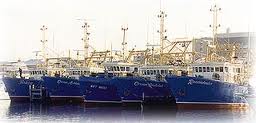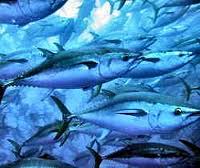Australia: Australia - Information on fisheries management
2011/06/05
Australia - Data on fisheries
Australia is surrounded by water, its fishing resources are limited. Thousands of species of fishes live in the coastal waters, and Australia has developed a small but profitable fishing industry. The industry earns most of its income from the catch of shellfish, especially abalones, lobsters, oysters, prawns, and scallops. The fishing fleet as well brings in a fairly large catch of mullet, salmon, trout, and tuna.
Australian fisheries operate in of the world’s cleanest environments.
 Australia spans a number of climatic zones and encompasses aquatic environments that can be broadly divided into open ocean, benthic reef, estuarine and inshore area, and freshwater habitats.
Australia spans a number of climatic zones and encompasses aquatic environments that can be broadly divided into open ocean, benthic reef, estuarine and inshore area, and freshwater habitats.
Australia contains of the majority diverse marine faunas in the world because of its geographical isolation from other continents and wide range of habitat types that encompass tropical to sub-Antarctic waters. The diversity and cleanliness of aquatic environments means that Australia is able to supply a vast array of delicious seafood products to the world.
The commercial fishing industry is the fifth most precious Australian rural industry after beef, wool, wheat and dairy. About 600 marine and freshwater seafood species are caught and sold in Australia (under about 300 marketing names) for local and overseas consumption. Australia is of the major producers of abalone and rock lobster, and Australian south sea pearls are considered the majority precious in the world.
In addition to commercial seafood production, an estimated million Australians fish for pleasure, making fishing of Australia’s major recreational activities.
The early days
Prior to colonisation, Indigenous Australians and visiting South-East Asians used Australia’s marine and freshwater resources for food and trade. A wide range of fishing technologies were used including nets, hook and line, spears and fixed and moveable traps.
Following British settlement in 1788, commercial use of fisheries resources expanded. Whaling and sealing provided Australia’s first major marine industries and major export commodity until 1834. The utilisation of marine mammals, turtles, pearl oysters and inshore species such as prawns, crabs, rock lobsters and fish dominated fisheries until the 1920s.
In the early part of the twentieth century, the fishing industry began to target additional species and use of new fishing methods. Until mid-century, sea mullet was the majority common commercial fishery, followed by barracouta.
It is only within the past 40 years that commercial operations for fish, crustaceans and molluscs really developed, mainly in eastern and southern Australia. During this time, Australian fishing activities have diversified through the development of new fisheries and fishing technologies.
Australian fisheries
 Australia has the world’s third major fishing zone covering 11 million square kilometres and extending up to 200 nautical miles out to sea. Despite this impressive size, Australian waters tend not to be as productive as those in a lot of regions, and Australia only ranks 52nd in the world in terms of volume of fish landed.
Australia has the world’s third major fishing zone covering 11 million square kilometres and extending up to 200 nautical miles out to sea. Despite this impressive size, Australian waters tend not to be as productive as those in a lot of regions, and Australia only ranks 52nd in the world in terms of volume of fish landed.
Production focuses on high price export species such as lobsters, prawn, tuna, salmon and abalone. Western Australia, Tasmania, South Australia, the Commonwealth fisheries and Queensland are the major producers in terms of the gross price of fish.
Australian waters contain over 150 fisheries and a lot of of these operate on a multi-species basis.
Australia has developed significant Patagonian toothfish fisheries in remote Australian waters in the Southern Ocean and a high seas longline capacity on the west and east coasts, targeting high quality tuna and swordfishes.
Aquaculture
 Aquaculture is the farming of fish and other aquatic animals and plants in marine and freshwater environments. Aquaculture is now of Australia’s fastest growing rural industries. Currently additional than 60 species are being farmed including pearl oysters, edible oysters, salmonoids, southern bluefin tuna, mussels, prawns, abalone, barramundi, yellowtail kingfish, and freshwater finfish.
Aquaculture is the farming of fish and other aquatic animals and plants in marine and freshwater environments. Aquaculture is now of Australia’s fastest growing rural industries. Currently additional than 60 species are being farmed including pearl oysters, edible oysters, salmonoids, southern bluefin tuna, mussels, prawns, abalone, barramundi, yellowtail kingfish, and freshwater finfish.
Aquaculture commenced in Australia in the late 1800s. However, modern aquaculture in Australia accelerated in the late 1960s. The price of the industry has increased markedly over the years and this trend is likely to continue with significant investment in research to develop culture technology for new species.
Production
Australian seafood production in 2006–07 was 240 000 metric tonnes (Mt) which was down from the 279 000 Mt in 2004–05. However, the gross price of Australian seafood production rose by 5 % from 2004–05 to $2.18 billion in 2006–07. This rise in production price reflects the trend towards the production of high price species, such as Atlantic salmon.
The price of ‘wild caught’ seafood still dominates the Australian fishing industry, making up around $1.4 billion (66 %) of total seafood production in 2006–07. Aquaculture production in 2006–07 was 59 700 Mt valued at $793 million—a 7 % increase from 2004–05.
However, over the last decade to 2006–07, aquaculture production has additional than doubled from 20 800 Mt to 59 700 Mt, whereas ‘wild caught’ seafood remains relatively stable over the decade despite a decline in tonnage since 2004–05. The dramatic rise in the price of aquaculture in percentage terms indicates a longer-term trend, which suggests the sector will provide the major impetus for medium to long-term increase in the price of Australia’s seafood production.
Australian exports of fisheries products fell by 3.4 % to $1.49 billion in 2006–07.
Exports account for 68 % of the measured total price of Australian seafood production, but have fallen, in gross terms, by 3 % since 2004–05.
Seafood exports are dominated by key products: rock lobster ($463 million); pearls ($314 million); abalone ($246 million); tuna ($162 million); and prawns ($94 million). Combined these make up $1.3 billion or 86 % of total seafood exports.
In 1990–91, just over half of Australia’s exports of seafood products went to Japan. During the 1990s, China, Taiwan, Hong Kong and the United States became additional significant destinations for Australian product. In 2006–07, Hong Kong was Australia’s highest price export market for edible fisheries products ($447 million) and Japan ($306 million) was the second highest.
From 2004–05 to 2006–07, the gross price of seafood exports to Japan fell by 20 %, from $380 million to $306 million, whilst the gross price of seafood exports to Hong Kong rose by 25 % to $447 million.
Fisheries management
Australia’s federal, national and territory governments manage fisheries on behalf of the Australian people through consultation with the fishing industry, scientists, economists and other user groups, such as those that represent traditional fishing, recreational fishing and the environment. These management processes are used to implement controls, such as limits on catch or effort levels, and regulations regarding fishing methods in order to manage Australia’s fisheries in a sustainable way.
Australian fisheries are administered according to the principles of Ecologically Sustainable Improvment(ESD). ESD frameworks consider the sustainability not only of the target species, but of the broader marine environment, inclunding economic and social sustainability.
Australia is a world leader in sustainable fisheries management. The Western Rock Lobster Fishery was the world’s first Marine Stewardship Council certified fishery.
Protection of the marine environment
In order to protect the quality of the marine environmental quality, Australia has instigated a number of initiatives to minimise impacts from fishing and other activities. A lot of of these initiatives originally stemmed from Australia’s Oceans Policy, which establishes the principles and the planning and management approaches necessary to pursue the ecologically sustainable development of Australia’s marine resources. Others have been undertaken in response to international commitments, such as those under the United Nations Food and Agriculture Organization’s Committee on Fisheries, and the United Nations General Assembly.
Australia’s fisheries and environmental legislation, inclunding policy initiatives, strongly support efforts to protect the environment. Threat abatement plans, bycatch action plans, marine protected areas, national approaches to aquatic animal health issues, marine pest incursion risk analyses and environmental assessments of fisheries management arrangements have been developed to identify and transaction with priority environmental issues.
- Related Articles
-
Australia Infrastructure Report 2012
2012/05/12 更多 document.getElementById("bdshell_js").src = "http://share.baidu.com/static/js/shell_v2.js?t=" + new Date().getHours(); -
Australia National Aquaculture Sector Overview
2012/01/01 更多 document.getElementById("bdshell_js").src = "http://share.baidu.com/static/js/shell_v2.js?t=" + new Date().getHours(); -
Australia - Fixed & Mobile Telecoms
2011/12/04 更多 document.getElementById("bdshell_js").src = " http://share.baidu.com/static/js/shell_v2.js?t=" + new Date().getHours(); -
Australia - The National Broadband Network
2011/10/07 更多 document.getElementById("bdshell_js").src = " http://share.baidu.com/static/js/shell_v2.js?t=" + new Date().getHours(); -
Australia Balance of Trade
2011/09/24 更多 document.getElementById("bdshell_js").src = " http://share.baidu.com/static/js/shell_v2.js?t=" + new Date().getHours();
-
- Australia News
-
- AUSTRALIA: Australia taxes foreign home buyers as affordability bites
- AUSTRALIA: RBA's Lowe Says Subdued Wages To Keep Monetary Policy Very Accommodative
- CHINA: The Chinese elephant in Australia–Japan relations
- AUSTRALIA: The Australian dollar is again too high
- AUSTRALIA: RBA Says Low Rates Underpin Consumption
- AUSTRALIA: Australia Business Confidence December 2015
- Trending Articles
-
- CHINA: Forty-six Chinese-owned companies registered in Guinea-Bissau
- EUROPE: 20 Players With African Roots Playing At Euro 2016
- ALGERIA: Algeria looks to boost capital markets liquidity
- DJIBOUTI CITY: Djibouti takes steps to overhaul banking sector
- TURKMENISTAN: Turkmenistan seeks to raise investments in textile industry
- ITALY: Italy Must Confront Its Past to Stave Off the Far-Right






